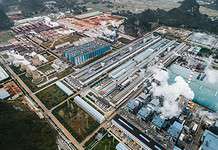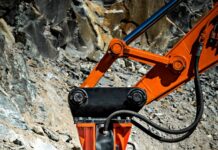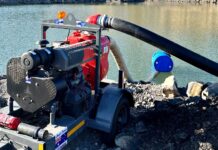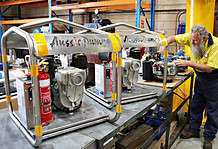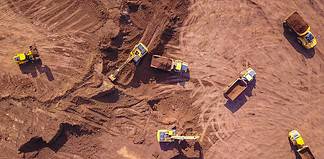AN increase in haul truck rolling resistance has been found to have a significant triple effect on costs, according to a recent study.
Research by Western Australian School of Mines professor Dr Rodger Thompson showed that fuel burn, plant damage and cycling times all suffer at the hands of a poor haul road surface.
He found three factors of a failing or uneven haul road sent operational costs up.
Firstly, the energy required to ‘climb’ the weight out of each depression in the road was adding up to 5pc in fuel costs; secondly, the increased cycling of suspension and friction on tyres was accelerating truck maintenance; and lastly, the cycle times were suffering badly.
The study found that the addition of only 3pc in rolling resistance was recording up to a 20pc increase in segment cycling times, pretty damning evidence that not enough attention is being paid to this high cost area of mining operations.
Square Impact = High Impact
The findings are not surprising for Adelaide-based roller manufacturer Broons, which says they were recognised by the company long ago and indeed have been addressed with the use of its unique Square Impact Rollers.
For more than three decades, Broons has been supplying Square Impact Rollers to eradicate these exact problems, so much so, that they have acquired legendary status.
The revolutionary patented BH-1300 Square Impact Roller was released into the world market in the mid-1980s, quickly bestowing Broons an international reputation as a specialist in the application and operation of rolling dynamic compaction equipment.
The square compactor module imparts a massive 50kJ with every blow.
With its high energy output, the Broons Square Impact Roller compacts deep beneath the surface in the subgrade layers to secure the haul road structure and minimising the risk of tyre and suspensions damage, detrimental to haul truck running costs.
Even today, no alternative compaction equipment comes close to the Impact Roller on performance, productivity and price.
Broons’ experience in rolling dynamic compaction is without equal around the globe and the unique equipment is used by international dredging contractors, civil engineering contractors, property developers, mining companies, state, local and Federal Government road agencies, along with cotton and rice growers.
In the mining sector, Broons’ enormous BH-1950MS Square Impact Roller has revolutionised the way to reduce tyre damage.
Never too tyred
Of course, the stronger the road surface the less the wear and tear on those expensive tyres.
Making an investment in an Impact Roller is quickly recouped by the savings made from improved tyre life and reduced damage to both the tyres and the haul truck suspension.
A number of mines are using the Broons Impact Roller to rubbilise rock on their tip heads and waste dumps as a way of improving their tyre management regime.
According to Broons director Stuart Bowes, mines are always looking for a solution to minimise premature wear and damage to haul truck tyres.
“It’s never ending. When times are good, high prices and low availability forces them to look for options to extend the life of tyres,” he said.
“When resource prices are low, operating cost savings are the driver for improving tyre life, there’s always a need for our equipment.”
Large or sharp rocks will slice through and critically damage even a brand new tyre, while smaller rocks can lodge between the lugs and eventually penetrate and puncture the tyre.
The Broons “MS” (Mine Specification) Impact Rollers are world leaders in minimising haul truck tyre wear by improving the running surface on haul roads, tip heads, and pit floors.
Supplied as a package with a suitably matched tow tractor, the Impact Rollers quickly reduce sharp edges and allow haul trucks to travel easily without the fear of tyre damage.
An improved running surface on haul roads and waste dumps has also shown it’s possible to reduce mechanical wear and tear on haul truck suspension and associated components, delivering lower overall maintenance costs.
Compaction and capping
Broons’ Impact Rollers have been employed in many other applications, including the compaction of capping layers on waste dumps where the equipment has proven to be both productive and cost-effective.
Capping layers are typically used to reduce the likelihood of spontaneous combustion in coal waste and overburden or the infiltration of surface water through mine waste that can lead to environmental problems with drainage and runoff.
Water infiltration and/or the convective transport of oxygen into a dump can be reduced to very low levels by constructing a low permeability compacted cover over the dump.
Test results and long-term ongoing use have shown that by placing around one metre of inert material over the waste and then compacting with a Square Impact Roller will pay dividends.
Studies undertaken by Professor Mark Jaksa and Dr Brendan Scott of the School of Civil, Environmental and Mining Engineering at the University of Adelaide have also shown that by using a single thicker capping layer, greater recycling of mine spoil materials can be used without the need to screen out large quantities of oversized materials.
Deep fills have traditionally been undertaken by compacting soil in thin layers using relatively small sized material placed in a highly controlled manner.
While conventional vibrating rollers can satisfactorily compact fill in layers up to 400mm thickness, studies at mine sites have shown that an Impact Roller can typically achieve thick-lift compaction in
layers of 500-1500mm, depending on the material composition and the number of passes by the roller.
With just six to 10 passes applied on the surface, improvement in density can occur to at least one metre, while 30-40 passes can result in significant improvement down to 2m and beyond in some materials.
Tailings are not the end
Broons Impact Rollers have been used on numerous tailings dams throughout Australia both to compact the central core or key, the floor to minimise permeability and during progressive raising ensuring absolute confidence in the integrity of the dam while identifying soft spots for remedial treatment.
Deep layers can be placed of around 500-1000mm ensuring maximum productivity, often using mining equipment rather than bringing in smaller civil engineering machines.
Going the distance
With the continued globalisation of mining and construction companies, there can be operations across many time zones. Broons employs sophisticated supply chain partners to support the demands of its truly international customers.
Since the 1980s, Broons has been sending their Square Impact Rollers via road, rail, sea and even air, to meet the demand from companies the world over.
Often matched with suitable tractors, the machines can be stripped down and quickly reassembled on site.
“Given most of our clients work in remote regions, the transport costs can be significant so our operations team spend a lot of hours finding the best transport solution,” Mr Bowes said.
“Often this can be dictated by the urgency of the need for the equipment.
“In the Middle East we flew 25 units with tractors, which was unprecedented; but our clients were working just three days after the equipment left our shores.”
Availability
Broons Impact Rollers are revered worldwide for transforming haul roads with their deep compaction, low maintenance and productivity.
Costing just a fraction of the savings to be made, a Square Impact Roller with matched tow tractor is ready for hire or purchase from Broons’ extensive Australia-wide fleet.
Broons is renowned for its commitment to customer service and provides full in-field operator training along with a comprehensive maintenance and spare parts service.
More information:
Broons Group Pty Ltd
Ph: (08) 8268 1988
[email protected]
www.broons.com




